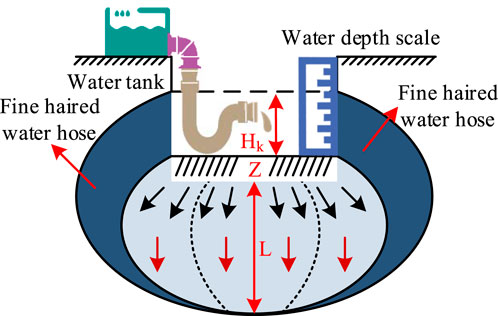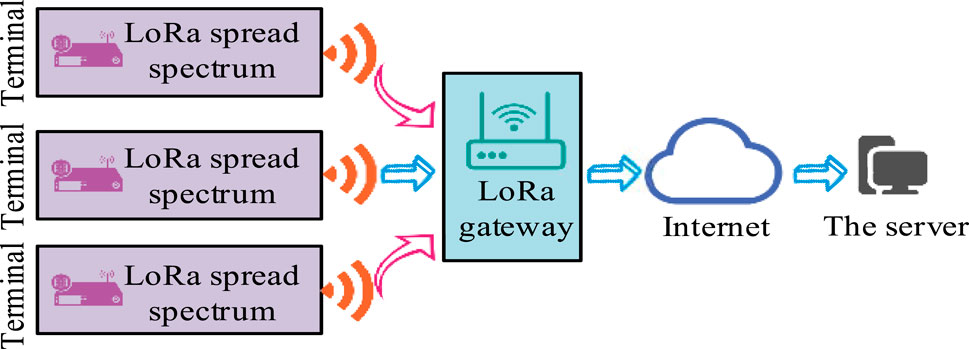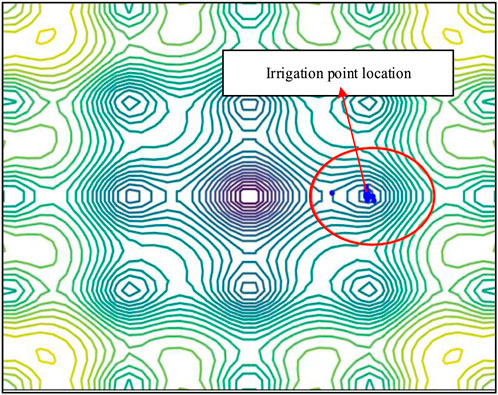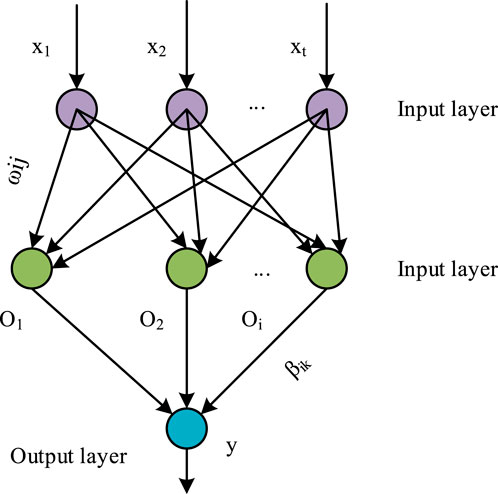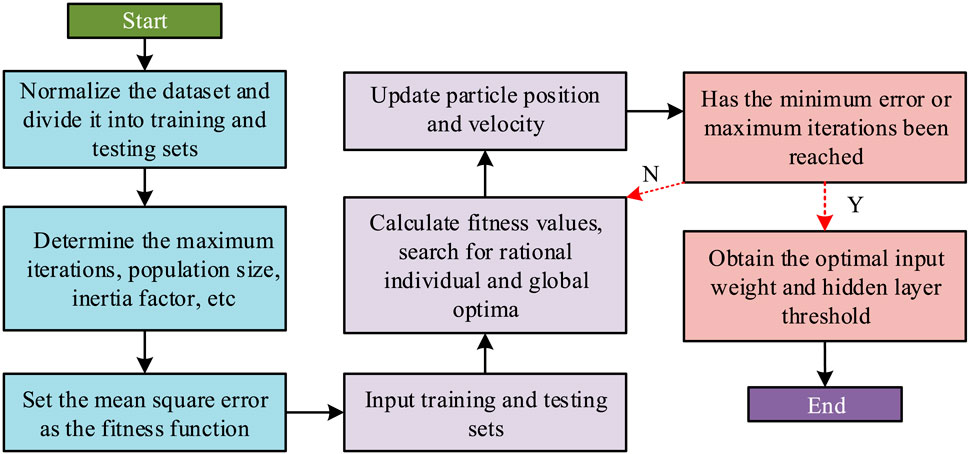- 1Henan Polytechnic, Zhengzhou, China
- 2School of Railway Transportation, Shanghai Institute of Technology, Shanghai, China
In response to the significant waste of agricultural irrigation resources and the inaccuracy of water demand predictions, this study aims to develop an automated irrigation system that can reduce fluctuations in water volume and enable precise control. Against the backdrop of current water scarcity and low agricultural water efficiency, improving irrigation precision is of great significance for ensuring food security and promoting sustainable agricultural development. This study combines particle swarm optimization algorithm with extreme learning machine and integrates it into a microcontroller to construct a new intelligent irrigation system. This technology can solve the problem of inaccurate crop water demand predictions in existing technologies and promote the transformation of intelligent agriculture from empirical to data-driven. This technology uses a LoRa based wireless sensor network to collect data and is controlled by a microcontroller. The particle swarm algorithm optimizes the initial parameters of the extreme learning machine, improving the accuracy with which it predicts farmland water demand. The results showed that the proposed method had the lowest root mean square error value, with an average of only 0.1025, indicating that the algorithm had the most accurate irrigation prediction effect. The automatic water-saving irrigation technology proposed in this study required less water compared to traditional irrigation techniques, with a minimum water consumption of 3015 m3/hm2 and a maximum water consumption of only 5268.3 m3/hm2. The system’s accuracy in predicting crop irrigation water demand could reach over 98%. The method proposed in this study can accurately control irrigation water. It can also maximize irrigation water conservation. This brings new research directions for the knowledge system of automated water-saving irrigation technology in farmland. It also provides new technical ideas for the development of intelligent agricultural irrigation technology.
1 Introduction
Although China is a sizable agricultural nation, there are disparities in the allocation of water resources both in space and time. Although agricultural irrigation water (IW) consumption accounts for 61.2% of total water consumption (WC), its effective utilization coefficient is only 0.559. This is significantly lower than the range of 0.7–0.8 observed in industrialized nations (Uddin and Dhar, 2020; Attri et al., 2022). Developing water-saving irrigation technology is crucial for alleviating water scarcity, reducing waste, and improving agricultural water use efficiency. The rise of smart agriculture has created new opportunities for upgrading irrigation systems with technologies such as the Internet of Things and artificial intelligence (Zhao et al., 2023). However, the current coverage rate of efficient, water-saving irrigation technology is relatively low. It is mostly concentrated in plains with superior conditions, which results in problems such as low irrigation efficiency, serious water resource waste, and high investment costs in vast areas. This is especially true in the central and western regions, where water resources are scarce (Pervaiz et al., 2022). Existing automated irrigation systems rely heavily on simple threshold control. They lack the ability to accurately predict crop water requirements, which makes it difficult for them to adapt dynamically to complex and changing environmental factors (Manoharan, 2021). Particle swarm optimization (PSO) and extreme learning machine (ELM), as efficient optimization and prediction tools, have demonstrated great potential in successful applications in fields such as energy load and financial forecasting. In view of this, this study aims to address the problems in farmland irrigation, overcome the shortcomings of existing farmland irrigation technologies, reduce the WC rate of farmland irrigation. Moreover, it designs an energy-saving and high-precision farmland IW consumption control system. This study will design automatic irrigation technology for farmland by combining microcontroller technology with PSO and ELM. The research expects that the PSO-ELM algorithm can significantly improve the performance of automatic irrigation technology in farmland and reduce water resource waste. The innovation of this study lies in combining two neural network algorithms to predict the irrigation amount of irrigation equipment. The application of this combination algorithm can not only save costs, but also be applicable to international irrigation standards.
This study mainly includes five sections. The first section primarily discusses the current state of IW resource utilization in farmland, existing research progress, and gaps. It also clarifies the theoretical and practical significance of this study. The second section primarily reviews the progress of applying domestic and foreign farmland irrigation technology and machine learning to agricultural irrigation. It also summarizes current research gaps. The third section is the methods and materials section. This section mainly introduces the hardware design of the automatic irrigation system for farmland and the calculation methods related to crop water demand. It also introduces the principle and implementation path of the PSO-ELM algorithm. The fourth section is the results section, which verifies the research effectiveness through experiments. The fifth section is for discussion and conclusion, summarizing the results of this study and pointing out the limitations and future prospects of the research.
2 Literature review
The issue of farmland WSI system design has been widely noticed and discussed by scholars at home and abroad. Zhao (2022) found that the WSI system could be combined with the IoT to achieve intelligent control. Therefore, the study proposed a design of WSI system based on IoT. The design was centered on wireless sensor network (WSN) sensor node design and coverage computation. The results showed that the system could perform smart irrigation in a timely and accurate manner. Ramkumar et al. (2021) found that water supply was being wasted in Indian farms. Based on this, the research suggested a technique to use IoT to automate the irrigation system in an attempt to save time and water. The findings demonstrated that farmers could more effectively regulate how much water was used for crop and livestock production. Water scarcity was a major danger to agriculture’s sustainable development, according to research by Yang et al. (2022). On the basis of this, the study suggested a WSI application that included guidelines for agricultural water conservation. The findings demonstrated a considerable rise in the agricultural IW’s effective usage coefficient. Zhou et al. (2022) found that the development of WSA was not only important for farmers to increase production and income, but also for the protection of water resources. Therefore, the study designed a stepped water price control system. The results showed that the system could greatly promote the sustainable development of WSA in China. Zha et al. (2022) found that WSA started earlier in Europe and achieved certain results. Therefore, a learning software for irrigation WSA was designed to improve information sharing. The results showed that the software played an important academic significance in the protection of water resources as well as the development of WSA.
The application of automatic control technology combined with machine learning in agricultural irrigation can greatly develop intelligent irrigation and improve water production efficiency. Ifriza and Sam’an (2021) found that rural water use was often limited by the flow of water from reservoirs, which led to an unbalanced distribution of rural water use systems. The study proposed a combination of correlation based feature selection (CFS) and an improved binary PSO method for optimizing irrigation management of agricultural reservoirs to address this issue. The results showed that the accuracy of the proposed method was 91.84%, much higher than similar algorithms. Veerachamy and Ramar (2021) (Veerachamy and Ramar, 2022) found that IoT in the agricultural sector could continuously provide agricultural information to the world, but lacked warnings about the irrigation needs of farmland. Therefore, the study first used neural networks to cluster the recommended irrigated farmland by agricultural experts, and then proposed an optimized PSO algorithm for predicting irrigation conditions. The results showed that the proposed method could accurately determine the irrigation demand and location based on soil moisture, temperature, wind speed, and other conditions in the agricultural field through the IoT. Behzadipour et al. (2023) found that the implementation of intelligent irrigation and adjustment of irrigation systems was crucial in today’s agricultural systems. Therefore, a combined model of measuring farmland air humidity through sensors and processing leaf images to adjust the microcontroller of the intelligent irrigation system was proposed. The results showed that the proposed model reduced the IW consumption by 11% compared to the previous year, demonstrating significant water saving benefits. To make the evaluation of IW use efficiency evaluation indicators more comprehensive and scientific, Dong et al. (2020) constructed a new optimization model for evaluation indicators, which took the indicator of irrigation machine driver pressure state influence correspondence and information significance difference as the evaluation benchmark. The results showed that the proposed model provided a simpler and more convenient index optimization system for the study of IW use efficiency evaluation indicators. Zhao (2022) further investigated the design of a WSI system based on IoT to address the serious problem of water waste in automatic farmland irrigation. At the same time, a WSI system structure model combining wireless sensors was built, and the farmland irrigation system was tested by wireless signals. The results showed that the system proposed by the research could perform intelligent irrigation in a timely and accurate manner. The comparison of the above literature methods is shown in Table 1.
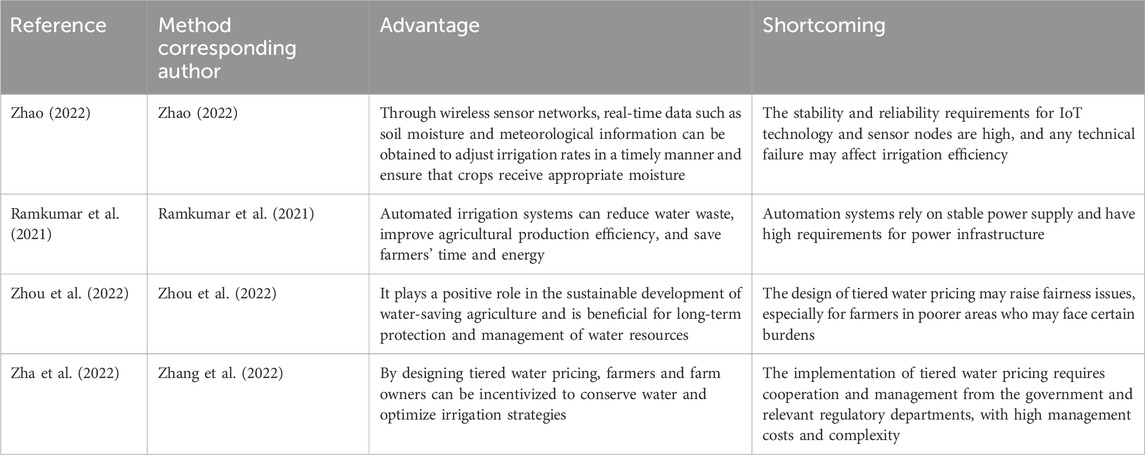
Table 1. Comparison of advantages and disadvantages of automatic water-saving irrigation methods for farmland mentioned in the literature review section.
The inclusion criteria for literature are as follows: (1) The research topic is agricultural automation and water-saving irrigation technology. It involves intelligent algorithms, the Internet of Things, and microcontroller applications. (2) The publication period is from 2021 to 2025. (3) The source is a peer-reviewed journal article. (4) Clear experimental data or validation results for method comparison are provided. The exclusion criteria are as follows: (1) Grey literature such as government reports, enterprise technology white papers, and unpublished dissertations. (2) Irrigation research in non-agricultural fields. (3) Literature that only describes theory without empirical verification. In conclusion, researchers from both domestic and foreign institutions have put forth a multitude of optimization strategies for the implementation of automatic WSI technology in agricultural settings. However, there has been a paucity of scholars who have employed neural network algorithms for the purpose of IW control prediction. Based on this, a field automatic WSI technology combining microcontroller technology with PSO and ELM is studied and designed. The two neural network algorithms are combined for predicting the irrigation amount of WSI devices.
The contribution of the methods proposed by the research to the existing relevant knowledge system is mainly reflected in the following aspects: (1) The research provides a new technological solution for WSI of farmland by integrating microcontroller technology, PSO, and ELM. This interdisciplinary technology integration helps promote the development of intelligent agricultural technology, especially in improving irrigation efficiency and water resource utilization. (2) The optimized algorithm can be used as part of an intelligent irrigation control system to reduce manual intervention and increase the level of automation in irrigation management through automatic control and intelligent decision making. (3) The research results can serve as a part of the intelligent agricultural technology system, promote the transformation of agriculture from “empirical” to “precise” development, and provide new impetus for accelerating agricultural modernization. (4) The efficacy of the algorithm is validated through simulation experiments in this study, thereby bridging the gap between theoretical research and practical applications. The transformation and implementation of scientific research outcomes is facilitated, and tangible technical solutions for the domain of farmland irrigation are provided.
3 Methods and materials
The study addresses the issues of automated WSI system in agricultural fields. Firstly, for the selection of network sensors for the irrigation system is explained and the experiment finally selects long range radio (LoRa) as the transmission network. Then the influencing factors of crop water demand are calculated to facilitate the control variables. This is the basis for the proposal of the PSO-ELM combined control algorithm and the explanation of its operation logic.
3.1 Circuit MCU design for automatic WSI technology in farmland
Before implementing automatic irrigation technology for agricultural crops, several key issues need to be addressed to ensure the effectiveness and sustainability of the technology. First, it is necessary to understand and study the growth habits and water requirements of agricultural crops at different stages of growth. The control of IW usage also relies on understanding soil moisture. If the soil moisture meets the standard, only a small amount of irrigation or no irrigation is needed. Otherwise, it is necessary to control the amount of water used for plant irrigation. Under different weather conditions, the volatilization of soil moisture in agricultural crops varies. The study introduces the Penman Monteith formula to calculate crop evapotranspiration, as shown in Equation 1.
In Equation 1,
In Equation 2,
In Figure 1, the study sets the diameter of the inner ring of the measurement ground plane to 0.25 m, while the diameter of the outer ring is 0.5 m, and the measurement depth is 0.5 m in both cases. However, the centers of the inner ring and the outer ring overlap, and they are both rooted into the soil at a depth of 0.1 m. When the height of the water level in the outer ring Hk reaches 0.1 m, irrigation is not required. The two-ring infiltration method, on the other hand, observes WC once every 5 min and transmits the changes to the observation terminal via sensors. The infiltration rate is calculated as shown in Equation 3.
In Equation 3,
In Equation 4,
In Equation 5,
In Equation 6,
After confirming the signal sensors covering farmland, it is necessary to use micro control unit (MCU) technology as the control terminal to control the circuit. MCU is a portable product with high integration, small size, high reliability, strong control function, low voltage, low power consumption, and easy production. The application fields of MCU are very extensive, such as smart meters, real-time industrial control, communication devices, navigation systems, household appliances, etc. The hardware architecture of the WSI system for farmland research and design is shown in Figure 3.
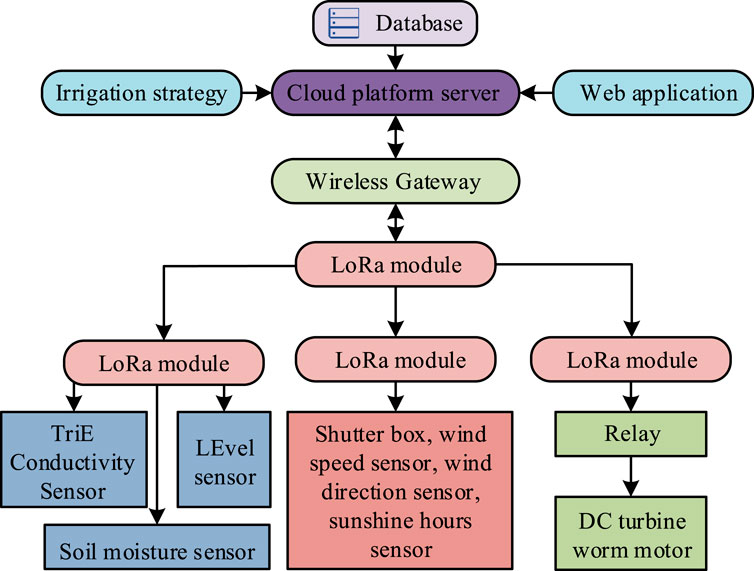
Figure 3. Schematic diagram of the hardware architecture of the agricultural WSI system designed for research.
In Figure 3, the power supply module is involved to drive the power supply to control the operating voltage of all the sensors in the irrigation system. In addition to this, the study considers the atmospheric pressure, natural wind speed, sunlight light intensity and natural humidity in the air environment. Therefore the optimization system such as louver box, soil moisture sensor and light sensor are added to the irrigation system.
3.2 Predictive irrigation technology based on PSO-ELM algorithm for crop water use in farmland
After the hardware configuration planning of the automatic WSI technology in farmland is completed, it is also necessary to consider the accuracy of the irrigation system in controlling the amount of IW demanded by farmland crops. Based on this, the study introduces PSO to effectively solve the water demand projection of the irrigation space. PSO is a stochastic search technique that first requires the initialization of all particles and their positions and velocities to imitate the foraging behavior of flocks of birds and collective intelligence (Liu et al., 2021; Camacho-Villalón et al., 2021; Demir and Sahin, 2023). At the outset of the calculation, the study normalizes all water data to ensure the algorithm’s generalizability and accelerate the convergence speed of the algorithmic learning process. The normalization equation is shown in Equation 7.
Equation 7 represents the linear normalization function. Among them,
In Equation 8,
In Equation 9,
In Equation 10,
In Equation 11,
However, the PSO algorithm also has drawbacks in that it cannot optimize the collected point data in the implicit layer, and it can confuse and overlap with the recorded data, which affects the accuracy of irrigation prediction. To enhance the irrigation system’s computational accuracy and learning speed, the study presents the ELM method, which is based on the PSO algorithm. The novel feature of the ELM algorithm is that it significantly decreases computation because the connection weights between the implicit and input layers can be set randomly and do not need to be modified repeatedly (Bandewad et al., 2023). The second is that the connection weights do not need to be adjusted iteratively and can be solved at once by solving a system of equations. The study assumes a neural network with L hidden points. Its expression is shown in Equation 12.
In Equation 12,
The nodes of the single-layer implicit neural network can be derived from Equation 13, which is calculated as shown in Equation 14.
In Equation 14,
In Equation 15,
According to Equation 16 the MinV as well as the unique value can be measured accurately. Combining the aforementioned requirements, Figure 5 depicts the ELM algorithm’s network topology.
The final project builds an intelligent automatic WSI system for farming based on the PSO-ELM algorithm, combining the benefits of the two algorithms. The PSO-ELM algorithm constructed by the study firstly needs to normalize the collected historical data of IW use, and then set the training set and test set. Immediately after that, an implicit node restriction needs to be applied to the input data set of the ELM. It is then subdivided into the output layer, as well as the need to set restrictions on the number of training iterations, IW particle intervals for the PSO algorithm. The study adopts mean squared error (MSE) as the regression evaluation index and calculates the single crop water requirement as the optimization benchmark to adjust the global particles. The study then investigates the final optimal parameter that can be obtained by comparing the error minimization records for the number of iterations. This parameter will be applied as a representative index in the irrigation system. In summary, the operation logic of the PSO-ELM algorithm proposed by the study is shown in Figure 6.
3.3 Experimental design and evaluation methods
This study uses data from two sources. The first source is a historical dataset of major farmland ecological sites in northern China from 2003 to 2025, published by the China Meteorological Science Data Center. The second source is real-time data collected by a sensor network deployed in a wheat-maize rotation experimental field in the North China Plain. The historical dataset has a data volume of approximately 1.2 GB and includes over 400000 valid daily records. Each record contains 14 original characteristic variables, including average temperature, maximum temperature, minimum temperature, average relative humidity, average wind speed, sunshine hours, precipitation, and reference crop evapotranspiration calculated using the Penman Monteith formula. Meteorological data is collected once a day. To match irrigation decision-making needs, soil moisture data is generated through virtual sensors at a frequency of once every 30 min. Moreover, its daily average is calculated and included in the dataset. During the 120 days experimental period, the real dataset deploys 5 soil moisture sensors and 1 micro meteorological station in each experimental field, collecting over 17000 valid data records. In the experiment, data cleaning, feature selection, and dataset partitioning are required. First, quality control is applied to the raw data to eliminate outliers that are clearly beyond the physical range. For a small number of missing values, time series linear interpolation is used to fill in. Then, based on the principles of agricultural hydrology, characteristics directly related to crop water demand are selected. These characteristics include temperature, humidity, wind speed, sunshine, and soil moisture. The Pearson correlation coefficients between all preliminary characteristics and actual IW requirements are calculated, and characteristics with correlation coefficients below 0.1 are excluded. Thus, eight characteristics are determined for the model input, including average temperature, daily maximum temperature, average relative humidity, average wind speed, sunshine hours, previous day soil moisture, cumulative precipitation, and reference crop evapotranspiration. Finally, the 7:3 ratio is divided into training and testing sets.
After completing data preprocessing, to fairly evaluate the performance of PSO-ELM, the study selects backpropagation neural network (BPNN), wavelet neural network (WNN), and standard extreme learning machine (ELM) as baseline models for comparison. The comparative indicators include prediction error RMSE, MAE, as well as goodness of fit R2 and actual water-saving effect. To avoid the limitations of traditional voting counting methods, this study used effect size analysis to quantify the performance differences between PSO-ELM and various baseline models. This was done by calculating Cohen’s d and combining it with an independent sample t-test to verify the statistical significance of the differences (α = 0.05). This ensured the statistical robustness of the model comparisons. To address the issue of incomparability caused by dataset heterogeneity, time scale differences, and differences in indicator dimensions, this study standardizes all indicators. For error indicators such as RMSE and MAE, the min max scaling method is used to convert them to the [0, 1] interval to eliminate the influence of dimensionality. To account for variations in data types and time periods, these standardized metrics must be further converted into z-scores. All data should be uniformly transformed to a common baseline for description, ensuring fair comparisons across different scenarios. To enhance the objectivity of experimental quality evaluation, this study uses inter rater reliability for testing. Two researchers with agricultural intelligent algorithm backgrounds independently verifies the accuracy of experimental data input and the accuracy of evaluation index calculation. Subsequently, Cohen’s kappa coefficient is used to quantify consistency, with a kappa coefficient of 0.92, indicating excellent consistency.
4 Results
To verify that the proposed PSO-ELM algorithm can improve the WSI system, the experiment firstly analyzes the error of the algorithm and compares the R2 value, so as to prove the effectiveness and advantages of the algorithm. Second, the PSO-ELM algorithm is combined with the WSI system to carry out experiments to compare the results of monitoring soil moisture and sunshine hours, which are the indicators of irrigation impact. Finally, the WC and crop output of the technology are compared.
4.1 Impact analysis of PSO-ELM algorithm on automatic WSI technology in farmland
To ascertain whether the PSO-ELM algorithm and microcontroller proposed by the research can enhance the efficacy of automatic WSI technology in agricultural settings, a series of experiments are conducted. First, in order to determine the optimal values of population size, iteration times, and inertia weights in the proposed algorithm, this study designs ablation experiments. By holding other parameters constant and altering the target parameter’s value, the optimal parameter combination is selected through comparing the model’s RMSE, MAE, and R2 values on the test set, as well as the accuracy of water demand forecasts. ELM has 30 hidden layer nodes, activation function Sigmoid, and regularization coefficient 0.01. The results are shown in Table 2.
In Table 2, when the population size is 10, the RMSE is 0.186, which is the maximum. R2 is the smallest at 0.921. The insufficient number of particles at this time results in inadequate coverage of the search space. This makes it difficult to find the optimal initial parameters for ELM. As the population size increases, particle diversity improves, search accuracy improves, RMSE decreases, and R2 increases. However, when the population size exceeds 30, RMSE increases. The reason is that too many particles lead to computational redundancy and are prone to oscillations around local optimal values. This results in comprehensive performance and computational efficiency. When the number of iterations is 50, the RMSE is 0.215, which is the maximum. At this point, the particles have not fully explored the parameter space. When the number of iterations gradually increases to 300, RMSE continues to decrease and R2 increased, indicating that increasing the number of iterations promotes parameter optimization. When the number of iterations is 400, the RMSE decreases by only 0.001. This indicates that the performance improvement is relatively small, but the iteration time increases significantly. When the inertia weight is 0.07, the RMSE is the smallest at 0.103 and the R2 is the largest at 0.986, indicating a balance between global and local search. Overall, it can be determined that the optimal population size is 30, the optimal number of iterations is 300, and the optimal inertia weight is 0.7. Then, the PSO-ELM algorithm is used to analyze the error in determining irrigation demand. The experiment introduced BPNN, WNN, and single ELM method. The comparison results are shown in Figure 7.
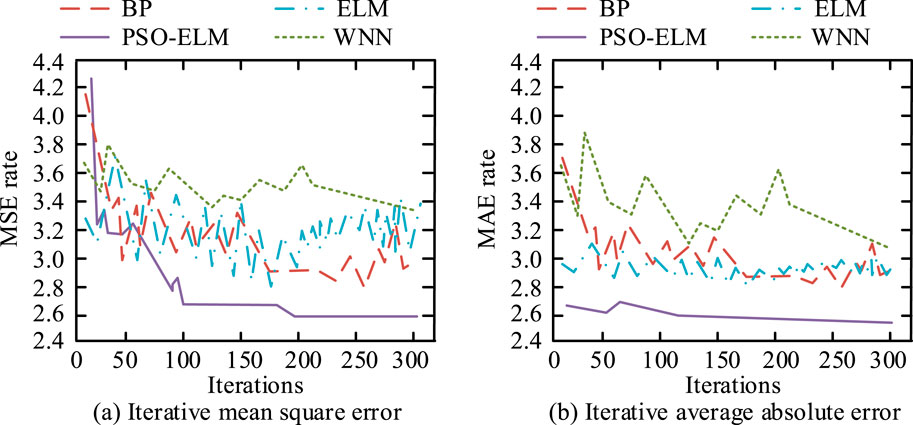
Figure 7. Comparison of RMSE and MAE results of four methods. (a) Iterative mean square error. (b) Iterative average absolute error.
In Figure 7a, the MSE of the proposed PSO-ELM algorithm under study reduces with the increase in the iterations and the curve shows a decreasing state. The maximum of the MSE appears before 50 iterations with a value of 4.3. Its error curve stabilizes when it is iterated up to 100 times. The minimum occurs in the interval of 200–300+ iterations with a value of 2.6. This indicates that the calculation error of PSO-ELM algorithm tends to stabilize with the increase of irrigation demand. The MSE curve of the WNN algorithm is at the top, indicating that the error is large and the algorithm has a poor impact. The MaxV of the root mean squared error (RMSE) for WNN is 4.19 and the MinV is 3.4. In Figure 7b, the mean absolute error (MAE) of the proposed PSO-ELM algorithm of the study reduces with the increase in the iterations, and the curve shows an overall flat decreasing state. This indicates that the proposed method has the lowest error and overall performance is relatively stable. The maximum MAE occurs in the interval of 50–100 iterations, with a value of 2.7. Its error curve stabilizes after 100 iterations, and the minimum occurs in the interval of 250–300+ iterations, with a value of 2.3. The MAE curve of the WNN algorithm remains at the top, indicating that the mean absolute error between the algorithm’s predicted and true values is large and the algorithm has little impact on the irrigation system. The MaxV of the RMSE of WNN is 3.9 and the MinV is 3.1. The above data proves that the research’s proposed combined algorithm has smaller calculation errors than other similar algorithms. It has a minimum mean square error of 2.6 and 2.3, respectively, which greatly improves the irrigation system. The experiment employs the PSO-ELM and WNN algorithms to predict evapotranspiration of crops. These algorithms exhibit a notable discrepancy in error, thereby further substantiating the merits of the proposed algorithm. The test results are shown in Figure 8.

Figure 8. Comparison of two methods for predicting crop evapotranspiration. (a) PSO-ELM prediction of evapotranspiration. (b) WNN prediction of evapotranspiration.
In Figure 8a, the maximum phase of predicted volatilization of evapotranspiration by the proposed method of the study appears between 0–50 days and 400–450 days, with a high value of 9.6 mm. However, the minimum phase of volatilization occurs between 248 and 276 days, with a value of −1.8 mm. The actual volatilization is in line with the range of predicted volatilization peaks and troughs, with a maximum of 9.5 mm and a minimum of −1.9 mm. Peak and troughs are in agreement with the prediction of the data both differed by 0.1 mm. It can be clearly seen from Figure 8a that the predicted volatility curve is close to the actual volatility curve, indicating that the PSO-ELM algorithm can accurately predict crop evapotranspiration. In Figure 8b, the prediction results of CET by the WNN algorithm differs greatly from the actual evapotranspiration results. The maximum stage of evapotranspiration predicted volatilization occurs between 0 and 50 days, which is as high as 9.9 mm. However, the minimum stage of volatilization occurs between 200 and 250 days, with the value of −2 mm. The MaxV of actual volatilization is 10 mm, and the MinV is −1.9 mm. This indicates that the method does not enhance the performance of the irrigation system. In general. The predictive performance of the PSO-ELM algorithm is superior, with a maximum difference of only ±0.1 mm from the actual volatilization amount. It can provide decision-making reference for saving IW. The experiment concludes with a comparison of the R2 and RMSE results of the four methods as a means of verifying that the proposed algorithm of the study is able to locate the point of the crop to be watered faster. The results are shown in Figure 9.
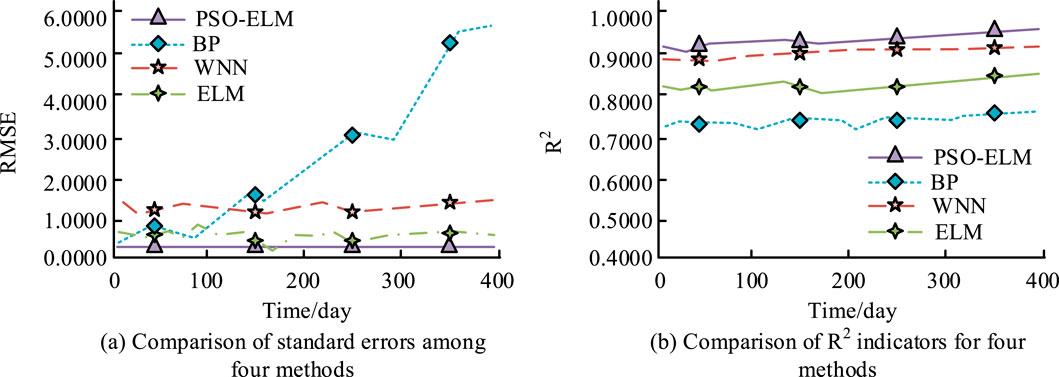
Figure 9. Comparison of R2 and RMSE results of four methods. (a) Comparison of standard errors among four methods. (b) Comparison of R2 indicators for four methods.
In Figure 9a, the RMSE value of the proposed method of the study is the lowest with a mean value of only 0.1025. It suggested that the PSO-ELM algorithm is the most accurate for irrigation prediction. The BPNN algorithm has the largest RMSE value of 5.0410. The RMSE value of ELM algorithm is second only to the value of the algorithm proposed in the study with a mean value of 0.6078. The mean value of RMSE of WNN algorithm is 0.7577. In Figure 9b, the higher value of R2 represents that the result is closer to the accurate value. The PSO-ELM algorithm has the largest R2 value of 0.9876. The BP algorithm has the smallest R2 value of 0.7889. The R2 values of WNN and ELM are in the middle of the range of 0.9188 and 0.8652, respectively. In summary, the PSO-ELM algorithm proposed in the study can greatly enhance the performance of the automatic irrigation system. It is able to control irrigation accurately and at the same time predict the factor variables rationally. The algorithm can provide strong technical support for the accuracy and energy saving of irrigation technology.
4.2 Experimental analysis of automatic WSI technology for farmland based on PSO-ELM algorithm and MCU
In order to verify that the PSO-ELM combination algorithm proposed in the study has more accurate water control for farmland irrigation, the climate conditions of a certain irrigation plain are referred to as the data for the test set, and simulation experiments are conducted. Due to the limited geographical location of the experiment, a static application is chosen. At the outset of the experiment, it is hypothesized that dynamic applications necessitate a dynamic data simulation system capable of updating and responding to farmers’ inputs in real time. This is to ensure that the application can reflect changes and demands in the real world at runtime. The final experiment uses Matlab R2019b software to simulate and calculate the irrigation model. The experimental observation period is 3600 days, involving the climate conditions, average wind speed, soil moisture, etc. of the plain. The training set data is sourced from the National Meteorological Science Center http://data.cam.cn. The test set data is shown in Table 3.
The experiment randomly selects 7 days of observation data to test the performance of the smart self-service WSI system on farmland. The irrigation impact indicators soil moisture as well as sunshine hours of these 7 days observation data are also compared. The monitoring results and measured results are shown in Figure 10.
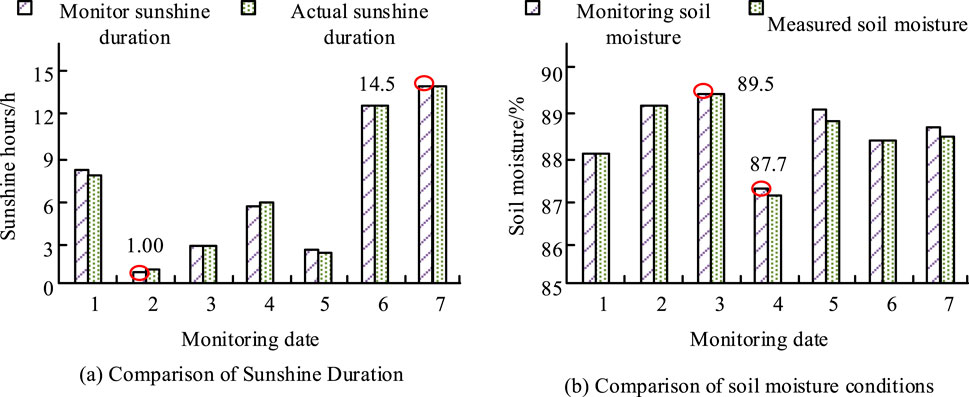
Figure 10. Comparison of sunshine count and soil moisture using the method proposed by the research. (a) Comparison of Sunshine Duration. (b) Comparison of soil moisture conditions.
In Figure 10a, the irrigation system based on PSO-ELM algorithm proposed by the study is more accurate in monitoring the sunshine hours. Among them, the monitoring results on days 3, 6, and 7 are consistent with the measured results. The longest sunshine hours occur on day 7 with 14.5 h. The shortest sunshine hours occur on day 2 with 1.00 h, and the measured hours are 1.05 h, with a difference of only 0.5 h. This indicates that the proposed algorithm is able to accurately control the sunshine information in the actual monitoring of the farmland. It is very useful for the control of soil moisture as well as the WC of plant irrigation. In Figure 10b, the proposed irrigation system based on PSO-ELM algorithm can accurately control the soil moisture in the farmland. The monitoring results on days 1, 2, 3, and 6 is consistent with the measured results. The highest value of soil moisture retention occurs on day 3 with a value of 89.5%. The lowest value of soil moisture retention occurred on day 4 with a value of 87.7% and the measured moisture is 87.0% with a difference of 0.7%. This shows that the proposed method can control the soil moisture in the farmland to be irrigated, which can provide an accurate reference for the water supply of the WSI system. At the end of the experiment, the crop yield and WC of the irrigated plain are analyzed, and simulation experiments are conducted by combining traditional methods of artificial irrigation with the methods proposed in the research. The results are shown in Figure 11.
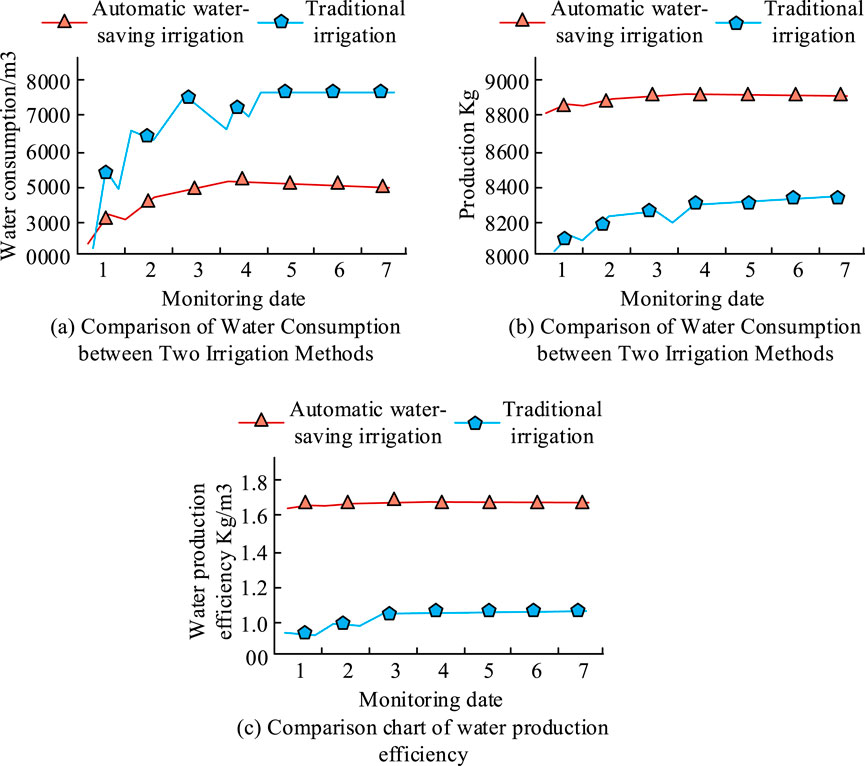
Figure 11. Comparison of production efficiency between traditional irrigation methods and research methods. (a) Comparison of Water Consumption between Two Irrigation Methods. (b) Comparison of Water Consumption between Two Irrigation Methods. (c) Comparison chart of water production efficiency.
In Figure 11a, the proposed automatic WSI technique for farmland based on PSO-ELM algorithm is studied with less WC. The maximum WC of the traditional irrigation method appears on day 3 with a value of 7647.1 m3/hm2. The minimum WC of the irrigation system proposed by the study appears on day 1 with a value of 3015 m3/hm2. The maximum WC appears on day 4 with a value of 5268.3 m3/hm2. In Figure 11b, the difference in crop yield between the two irrigation methods is also large. The maximum crop yield of the irrigation system mentioned in the study is 8840.5 kg/hm2. However, the maximum crop yield under the conventional irrigation method is only 8260.5 kg/hm2 and the minimum yield is 8009.3 kg/hm2. In Figure 11c, the water productivity varies between the two irrigation methods. The MaxV of water production efficiency of the irrigation system proposed by the study is 1.68 kg/m3. Whereas, the water production efficiency of the conventional irrigation method is lower with a value of 1.06 kg/m3. The above data shows that the irrigation system with the control algorithm proposed by the study is able to use less IW. This produces more crop volume and higher water supply efficiency, which is a better overall performance than traditional irrigation methods. This method can greatly achieve the effect of WSI, and plant irrigation. To further verify the effectiveness of the microcontroller-based automatic irrigation system using the PSO-ELM algorithm, a 120-day field experiment was conducted in a wheat-maize rotation area in northern China. The experiment is divided into a control area and an experimental area, each with an area of 1 ha. The control area adopts conventional irrigation methods, while the experimental area deploys the proposed automatic irrigation system. During the experiment, the total IW consumption, crop yield, and water productivity are recorded. The results are shown in Table 4.
As shown in Table 4, the total IW consumption of the proposed system is 4,326.8 ± 198.7 m3/hm2, which is significantly lower than that of conventional irrigation methods. The proposed system can save 38.1% of water, which is a statistically significant difference (p < 0.05). The crop yield of the proposed system is 8765.3 ± 192.1 kg/hm2, while the crop yield of conventional irrigation methods is 8125.6 ± 285.4 kg/hm2. Compared with conventional irrigation methods, the proposed system increases yield by 79%, with a significant difference (p < 0.05). The water productivity of the proposed system is 2.03 ± 0.11 kg/m3, which is much higher than that of conventional irrigation methods. There is a significant difference between the two (p < 0.05). The above results indicate that the proposed system can adapt to real fluctuations in agricultural environments, proving its effectiveness and reliability in practical applications.
5 Discussion and conclusion
With the advancement of science and technology, China’s automatic IW-saving technology for farmland is also tending toward intelligent development, but there are also problems such as high water demand, high WC rate and high labor cost. To solve these problems, it is necessary to study how to accurately control IW consumption and improve water efficiency. Therefore, the study proposed an automatic WSI algorithm for farmland that combined microcontroller technology with the PSO-ELM algorithm. The results showed that the maximum mean square error of the PSO-ELM algorithm proposed by the research occurred before 50 iterations, with a value of 4.3 and a MinV of 2.6. The MaxV of the MAE index was 2.7 and the MinV was 2.3. This indicated that the combined algorithm proposed by the research had small calculation errors and could accurately irrigate according to irrigation needs and environmental characteristics, which greatly improved the entire irrigation system. In addition, the automatic WSI technology for farmland proposed by the research required less water, with a minimum WC of 3015 m3/hm2 and a maximum WC of 5268.3 m3/hm2. The accuracy of predicting the IW demand for crops using the irrigation system proposed by the research could reach over 98%. This study validates the effectiveness and enormous potential of data-driven methods that combine intelligent optimization algorithms and embedded hardware to solve complex problems in the optimization of agricultural systems. At the same time, it provides multiple insights for the development path of intelligent agriculture. For agricultural technology promotion and policymakers, the importance of investing in agricultural IoT data infrastructure has been emphasized. Forward looking investment is needed in agricultural IoT data infrastructure. Data insights should be transformed into fair water-saving incentive policies. For agricultural engineers and data scientists, it reveals the necessity of interdisciplinary collaboration. The deep integration of advanced algorithms with reliable hardware requires full consideration of the complexity of the agricultural environment. It also requires consideration of the limitations of equipment computing power and the usage habits of farmers. The integration of computational intelligence tools provides agronomists and producers with an opportunity to quantify and model traditional planting experience. This shifts irrigation decisions from experience-driven to data-driven. However, this study still has some limitations. Although LoRa technology is an ideal choice for this system because of its low power consumption and ability to communicate over long distances, complex terrain in rural farmland environments may obstruct and attenuate signals, leading to unstable communication when the technology is deployed. The hardware cost of deploying a large number of sensor nodes, the maintenance cost in the later stage, and the requirement for farmers' technical literacy will also have an impact on its promotion. At the same time, the system’s economic feasibility has not been thoroughly analyzed. The initial cost of a complete automatic irrigation system, including sensors, microcontrollers, actuators, communication modules, and software development, is relatively high. The investment payback period between it and the long-term benefits brought by water-saving and income increase is still unclear. For small-scale farmers with weaker capital capacity, this is the core consideration in deciding whether to adopt this technology. Therefore, future research will optimize network topology, introduce relay nodes to enhance the robustness of LoRa networks in complex environments, and explore low-cost, open-source hardware solutions to reduce deployment costs. In addition, long-term and large-scale field trials will be conducted to quantify the comprehensive benefits of the system in terms of water conservation, yield increase, and labor savings. Detailed cost-benefit analysis will be conducted to provide clear economic feasibility reports for farms of different operating scales. Explore sustainable business models based on services. Examples include government or cooperative investment in building cloud platforms and infrastructure, as well as farmers using services through leasing or pay-as-you-go. These models lower the initial investment threshold for small farmers and improve the accessibility and scalability of technology.
Data availability statement
The original contributions presented in the study are included in the article/supplementary material, further inquiries can be directed to the corresponding authors.
Author contributions
HJ: Methodology, Validation, Conceptualization, Data curation, Resources, Writing – original draft, Writing – review and editing, Visualization, Formal analysis. DS: Methodology, Validation, Conceptualization, Data curation, Resources, Writing – original draft, Writing – review and editing, Visualization, Formal analysis. CZ: Methodology, Validation, Conceptualization, Data curation, Resources, Writing – original draft, Writing – review and editing, Visualization, Formal analysis.
Funding
The author(s) declare that financial support was received for the research and/or publication of this article. This study was supported by Henan Province Science and Technology Research Project: “Research on Key Technologies for Autonomous Driving of Tracked Vehicles for Smart Farms” (Project Number: 252102110365) and Henan Province Soft Science Research Project: “Research on the Current Situation and Countermeasures of Agricultural Machinery Equipment Industry Development under New Forms” (Project Number: 242400411017).
Conflict of interest
The authors declare that the research was conducted in the absence of any commercial or financial relationships that could be construed as a potential conflict of interest.
Generative AI statement
The author(s) declare that no Generative AI was used in the creation of this manuscript.
Any alternative text (alt text) provided alongside figures in this article has been generated by Frontiers with the support of artificial intelligence and reasonable efforts have been made to ensure accuracy, including review by the authors wherever possible. If you identify any issues, please contact us.
Publisher’s note
All claims expressed in this article are solely those of the authors and do not necessarily represent those of their affiliated organizations, or those of the publisher, the editors and the reviewers. Any product that may be evaluated in this article, or claim that may be made by its manufacturer, is not guaranteed or endorsed by the publisher.
References
Attri, M., Bharti, V., Ahmad Nesar, N., Mehta, S., Bochalya, R. S., Kumar Bansal, K., et al. (2022). Improved irrigation practices for higher agricultural productivity: a review. Int. J. Environ. Clim. Change 12 (9), 51–61. doi:10.9734/ijecc/2022/v12i930737
Bandewad, G., Datta, K. P., Gawali, B. W., and Pawar, S. N. (2023). Review on discrimination of hazardous gases by smart sensing technology. Artif. Intell. Appl. 1 (2), 70–81. doi:10.47852/bonviewaia3202434
Behzadipour, F., Ghasemi Nezhad Raeini, M., Abdanan Mehdizadeh, S., Taki, M., Khalil Moghadam, B., Zare Bavani, M. R., et al. (2023). A smart IoT-based irrigation system design using AI and prediction model. Neural Comput. Appl. 35 (35), 24843–24857. doi:10.1007/s00521-023-08987-y
Camacho-Villalón, C. L., Dorigo, M., and Stützle, T. (2021). PSO-X: a component-based framework for the automatic design of particle swarm optimization algorithms. IEEE Trans. Evol. Comput. 26 (3), 402–416. doi:10.1109/TEVC.2021.3102863
Demir, S., and Sahin, E. K. (2023). Predicting occurrence of liquefaction-induced lateral spreading using gradient boosting algorithms integrated with particle swarm optimization: pso-xgboost, PSO-LightGBM, and PSO-CatBoost. Acta Geotech. 18 (6), 3403–3419. doi:10.1007/s11440-022-01777-1
Dong, L., Lihui, Z., Heng, L., Qiang, F., Mo, L., Faiz, M. A., et al. (2020). Optimization of irrigation water use efficiency evaluation indicators based on DPSIR-ISD model. Water Supply 20 (1), 83–94. doi:10.2166/ws.2019.135
Ifriza, Y. N., and Sam’an, M. (2021). Irrigation management of agricultural reservoir with correlation feature selection based binary particle swarm optimization. J. Soft Comput. Explor. 2 (1), 40–45. doi:10.52465/joscex.v2i1.23
Liu, L. W., Ismail, M. H., Wang, Y. M., and Lin, W. S. (2021). Internet of things based smart irrigation control system for paddy field. AGRIVITA J. Agric. Sci. 43 (2), 378–389. doi:10.17503/agrivita.v43i2.2936
Manoharan, J. S. (2021). Study of variants of extreme learning machine (ELM) brands and its performance measure on classification algorithm. J. Soft Comput. Paradigm (JSCP) 3 (02), 83–95. doi:10.36548/jscp.2021.2.003
Pervaiz, S., Bangyal, W. H., Ashraf, A., Nisar, K., Haque, M. R., Ibrahim, A., et al. (2022). Comparative research directions of population initialization techniques using PSO algorithm. Intell. Autom. Soft Comput. 32 (3), 1427–1444. doi:10.32604/iasc.2022.017304
Ramkumar, P., Uma, R., and Valarmathi, R. (2021). Smart water irrigation system using IoT. J. Contemp. Issues Bus. Gov. 27 (3), 1826–1833. doi:10.47750/CIBG.2021.27.03.232
Shi, H. (2021). Performance of community-based water-saving technology under land fragmentation: evidence from groundwater overexploitation in the north China plain. Water Policy 23 (6), 1542–1555. doi:10.2166/wp.2021.138
Uddin, M. T., and Dhar, A. R. (2020). Assessing the impact of water-saving technologies on boro rice farming in Bangladesh: economic and environmental perspective. Irrigation Sci. 38 (2), 199–212. doi:10.1007/s00271-019-00662-2
Veerachamy, R., and Ramar, R. (2022). Agricultural irrigation recommendation and alert (AIRA) system using optimization and machine learning in hadoop for sustainable agriculture. Environ. Sci. Pollut. Res. 29 (14), 19955–19974. doi:10.1007/s11356-021-13248-3
Yang, X., Pu, Y., Weng, S., Hou, M., and Wang, Z. (2022). Review of agricultural water-saving policies and measures in recent Years–a case study of Jiangsu province, China. Water Supply 22 (4), 3951–3967. doi:10.2166/ws.2022.026
Zhang, S., Wang, X., and Zhou, L. (2022). A review on water-saving agriculture in Europe. J. Water Resour. Prot. 14 (4), 305–317. doi:10.4236/jwarp.2022.144015
Zhao, L. (2022). Design of intelligent water-saving irrigation system based on internet of things. Wirel. Eng. Technol. 13 (3), 33–40. doi:10.4236/wet.2022.133003
Zhao, J., Yu, Y., and Li, Z. (2023). Design and verification of wireless automatic drip irrigation system in corn field. Int. J. Inf. Technol. 15 (8), 4415–4425. doi:10.1007/s41870-023-01442-0
Keywords: automatic irrigation, combining algorithms, extreme learning machine (ELM), micro control unit, particle swarm optimization (PSO), water-saving agriculture
Citation: Ji H, Song D and Zhang C (2025) Automatic water-saving irrigation technology for farmland based on PSO-ELM algorithm and micro control unit. Front. Mech. Eng. 11:1619319. doi: 10.3389/fmech.2025.1619319
Received: 28 April 2025; Accepted: 13 October 2025;
Published: 03 November 2025.
Edited by:
Kanak Kalita, Vel Tech Dr. RR and Dr. SR Technical University, IndiaReviewed by:
Swaty Dash, University College of Engineering, IndiaMantena Sireesha, Sasi Institute of Technology and Engineering, India
Copyright © 2025 Ji, Song and Zhang. This is an open-access article distributed under the terms of the Creative Commons Attribution License (CC BY). The use, distribution or reproduction in other forums is permitted, provided the original author(s) and the copyright owner(s) are credited and that the original publication in this journal is cited, in accordance with accepted academic practice. No use, distribution or reproduction is permitted which does not comply with these terms.
*Correspondence: Dongfang Song, c29uZ2RvbmdmYW5naG5AMTI2LmNvbQ==; Chuansheng Zhang, MTUxMDEyNjU2MjFAMTYzLmNvbQ==
 Hong Ji1
Hong Ji1 Chuansheng Zhang
Chuansheng Zhang